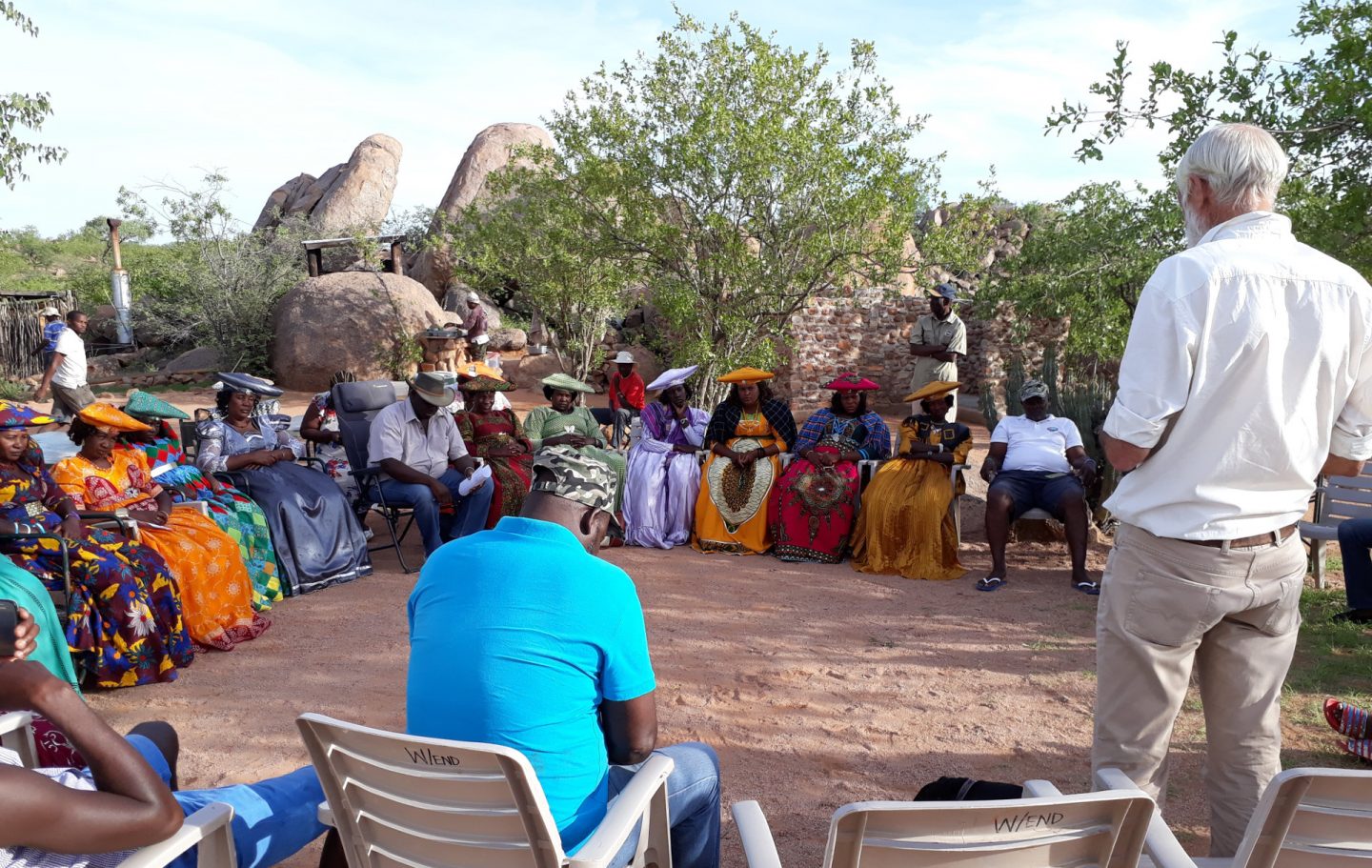
Through the Kunene People’s Park, IRDNC are looking to eventually put 1 million hectares of Namibia’s spectacular Kunene region under special protection. This region is home to desert adapted elephant, black rhino, giraffe, lion and cheetah. What makes this plan different from conventional national parks is that it builds on and enhances community ownership of wildlife and natural resources. The following is an account of one of the first key actions towards this…
Put 20 rural women from two different Namibian conservancies together on a four day mobile camping safari and expose them to magnificent scenery and wildlife, right on their doorstep. Show them the work that their conservancies are doing to protect wildlife, linking conservation to local development. Visit two lodges and some potential tourism sites, ripe for new investment. Along the way, discuss plans to form a new and progressive African version of a national park that empowers local people rather than curbing their rights, at the same time as strengthening wildlife conservation. The result is a powerful new team of committed conservationists – and a newly formed action group called Women for Conservation.
This recent safari into the 1,200Km2 Kunene region of north-western Namibia inspired the women to organise themselves into an action group to ensure that what they had learned on the expedition was passed on to others, including women in their conservancies, and is a first step towards the creation of Africa’s first People’s Park.

Tjavarekua Tjijahura, of Ehirovipuka Conservancy, the new group’s chair, said that from now on all the women also intended to attend conservancy meetings and would “become its wings”.
In the future they also wanted to be involved in lobbying government on important local conservation and tourism issues.
Several woman from both Omatendeda and Ehirovipuka conservancies said until they had seen for themselves during the safari the work being done by their conservancies, they were apathetic and under the impression that the committees and staff “just ate the conservancy income”.
Now, however, they were impressed and inspired by what the conservancies were trying to achieve, including pioneering the People’s Park, and they thanked conservancy committee members and staff for their hard work for the people and for wildlife.
Some women said they had no idea how beautiful the core wildlife areas of their conservancies were and they now believed these places should be kept for conservation of wildlife and for tourism.
Travelling together and hearing first-hand about the plans for the park as well as seeing the proposed boundaries, was useful because it dispelled rumours that some villages, such as those at Arizona, would need to be moved. They had learned that this was not true, and that only the “invaders” and their cattle from far outside the conservancies should be evicted.
Gustav Tjiundukamba, chairman of the Kunene Regional Communal Conservancy Association (KRCCA), reiterated this, pointing out that the two conservancies had already spent about N$318 000 in legal fees to evict outsiders who had moved large herds – owned by wealthy people from other areas – into conservancies’ core wildlife areas. The legal action had been successful but slow, and it had cost local people heavily in delayed tourism investment. Many new jobs could have been created by now, and much local income generated.
Roger Collinson of the People’s Park task force and a technical advisor to IRDNC, described the park area as “one of the most magnificent remaining landscapes, as yet undeveloped, for wildlife and tourism.” Collinson, an ecologist and specialist in tourism development, said that with a tourism investor already identified who had proved his commitment by putting money into both conservancies, the future looked bright.
History was being made by having women involved right from the beginning, John K Kasaona, director of IRDNC, said. Nothing new – and ground-breaking – came on a silver platter so there was a lot of work ahead. There would be people, including politicians, who would resist this new idea of the PP. Women were listened to by the politicians so it was important to have them with us on the journey ahead.
Speaking at the final wrap-up meeting, Dr Margaret Jacobsohn, a PP task force member, said that the new PP was also history in the making as it would be the first in Africa. She warned about the “hyena out there” – members of Namibia’s black elite who were interested in individual self-enrichment from conservancy tourism development rather than the upliftment of conservancy members. Benefitting a few people from the capital would not strengthen local conservation so it was the local people who should be having their quality of life enhanced.
Garth Owen-Smith, chairman of the PP task force and a Tusk Prince William Life Time Conservation Award winner, complimented the women for camping cheerfully in the rain and even sleeping near lions. Women from the two conservancies had forged a strong team with those involved in the PP, with women’s power harnessed, the project had been given an exceptional advantage.
